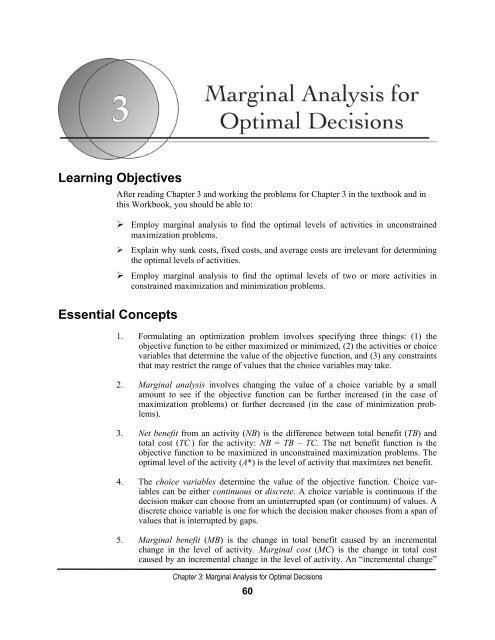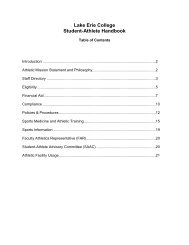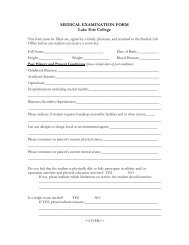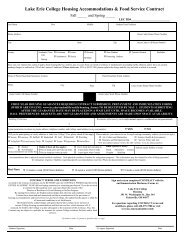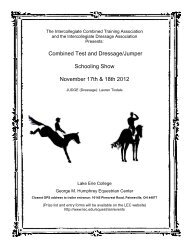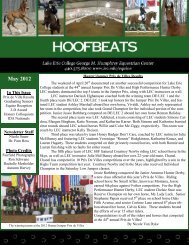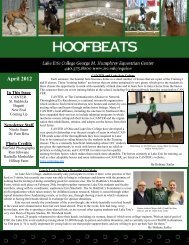Economics for Managers
Economics for Managers
Economics for Managers
You also want an ePaper? Increase the reach of your titles
YUMPU automatically turns print PDFs into web optimized ePapers that Google loves.
Learning ObjectivesAfter reading Chapter 3 and working the problems <strong>for</strong> Chapter 3 in the textbook and inthis Workbook, you should be able to: Employ marginal analysis to find the optimal levels of activities in unconstrainedmaximization problems. Explain why sunk costs, fixed costs, and average costs are irrelevant <strong>for</strong> determiningthe optimal levels of activities. Employ marginal analysis to find the optimal levels of two or more activities inconstrained maximization and minimization problems.Essential Concepts1. Formulating an optimization problem involves specifying three things: (1) theobjective function to be either maximized or minimized, (2) the activities or choicevariables that determine the value of the objective function, and (3) any constraintsthat may restrict the range of values that the choice variables may take.2. Marginal analysis involves changing the value of a choice variable by a smallamount to see if the objective function can be further increased (in the case ofmaximization problems) or further decreased (in the case of minimization problems).3. Net benefit from an activity (NB) is the difference between total benefit (TB) andtotal cost (TC ) <strong>for</strong> the activity: NB = TB – TC. The net benefit function is theobjective function to be maximized in unconstrained maximization problems. Theoptimal level of the activity (A*) is the level of activity that maximizes net benefit.4. The choice variables determine the value of the objective function. Choice variablescan be either continuous or discrete. A choice variable is continuous if thedecision maker can choose from an uninterrupted span (or continuum) of values. Adiscrete choice variable is one <strong>for</strong> which the decision maker chooses from a span ofvalues that is interrupted by gaps.5. Marginal benefit (MB) is the change in total benefit caused by an incrementalchange in the level of activity. Marginal cost (MC) is the change in total costcaused by an incremental change in the level of activity. An “incremental change”Chapter 3: Marginal Analysis <strong>for</strong> Optimal Decisions60
in activity is a small positive or negative change in activity, usually a one-unitincrease or decrease in activity. Marginal benefit and marginal cost can beexpressed mathematically asMB =MC =change in total benefitchange in activity= ΔTBΔAchange in total costchange in activity = ΔTCΔAwhere the symbol ) means the change in and A denotes the level of activity.6. Because “marginal” variables measure rates of change in corresponding “total”variables, marginal benefit and marginal cost are also slopes of total benefit andtotal cost curves, respectively. Marginal benefit (cost) of a particular unit ofactivity is measured by the slope of the line tangent to the total benefit (total cost)curve at that point of activity.7. If, at a given level of activity, a small increase or decrease in activity causes netbenefit to increase, then this level of activity is not optimal. The activity must thenbe increased (if marginal benefit exceeds marginal cost) or decreased (if marginalcost exceeds marginal benefit) to reach the highest net benefit. The optimal level ofthe activity is attained when no further increases in net benefit are possible <strong>for</strong> anychanges in the activity. This point occurs at the activity level <strong>for</strong> which marginalbenefit equals marginal cost: MB = MC.8. When a manager faces an unconstrained maximization problem and must chooseamong discrete levels of an activity, the manager should increase the activity ifMB > MC and decrease the activity if MB < MC . The optimal level of activity isthe last level <strong>for</strong> which MB exceeds MC.9. Sunk costs are costs that have previously been paid and cannot be recovered. Fixedcosts are costs that are constant and must be paid no matter what level of activity ischosen. Average (or unit) cost is the cost per unit of activity, which is computed bydividing total cost by the number of units of activity. Decision makers wishing tomaximize net benefit should ignore any sunk costs, any fixed costs, and theaverage costs associated with the activity because none of these costs affect themarginal cost of the activity, and so are irrelevant <strong>for</strong> making optimal decisions.10. The ratio of marginal benefit divided by the price of an activity (MB/P) tells thedecision maker the additional benefit of that activity per additional dollar spent onthat activity, sometimes referred to in<strong>for</strong>mally as “bang per buck.” In constrainedoptimization problems, the ratios of marginal benefits to prices of the variousactivities are used by managers to determine how to allocate a fixed number ofdollars among activities.11. To maximize or minimize an objective function subject to a constraint, the ratios ofthe marginal benefit to price must be equal <strong>for</strong> all activities,MB AP A= MB BP B= = MB ZP Zand the values of the choice variables must meet the constraint.Chapter 3: Marginal Analysis <strong>for</strong> Optimal Decisions61
Matching Definitionsactivities or choice variablesaverage (or unit) costconstrained optimizationcontinuous variablediscrete variablefixed costsmarginal analysismarginal benefitmarginal costmaximization problemminimization problemobjective functionoptimal level of activitysunk costsunconstrained optimization1. ___________________ Function to be either maximized or minimized.2. ___________________ Optimization problem in which the decision maker istrying to maximize some activity.3. ___________________ Optimization problem in which the decision maker istrying to minimize some activity4. ___________________ The determinants of the values of objective functions.5. ___________________ A variable that cannot take a continuum of values.6. ___________________ A variable that can take any value between two endpoints.7. ___________________ A situation in which a manager may choose the optimallevels of activities from an unrestricted set of values.8. ___________________ A situation in which a manager may choose the optimallevels of activities from a restricted set of values.9. ___________________ The analytical process of making incremental changes tothe level of the choice variables to arrive at the pointwhere no further improvements in the objective functionare possible.10. ___________________ The level of activity that maximizes net benefit.11. ___________________ The additional benefits derived per unit increase inactivity.12. ___________________ The additional cost realized per unit increase in activity.13. ___________________ Costs that have already been paid and cannot be recovered.14. ___________________ Costs that are constant and must be paid no matter whatlevel of activity is chosen.15. ___________________ Total cost divided by the number of units of activity.Chapter 3: Marginal Analysis <strong>for</strong> Optimal Decisions62
Study Problems1. a. Fill in the missing numbers below.ATotalBenefitTotalCostMarginalBenefitMarginalCostNetBenefit0 0 _____ xx xx 01 _____ _____ 10 _____ 82 _____ 5 9 _____ _____3 25 _____ _____ 4 _____4 _____ _____ _____ 6 155 34 22 _____ _____ _____b. Define “optimal level of activity.” In part a, what is the optimal level ofactivity? Why?c. In part a, marginal benefit does not equal marginal cost <strong>for</strong> any quantity.Does this mean there is no optimal level of activity? Why or why not?d. At the optimal level of activity, could you increase the level of activity andget an increase in total benefit? If so, why should the manager not increasethe activity further?2. The manager of a firm estimates that the sales of her firm are related to radio andnewspaper advertising in the following way:S = 12,000 + 1,800AR, whereS = the number of units sold,A = the number of quarter-page newspaper advertisements, andR = the number of minutes of radio spots.a. Derive the marginal benefit of newspaper and radio advertising. [Hint: Themarginal benefit of advertising can be found by determining how much Schanges <strong>for</strong> each one-unit change in A, holding R constant.]ΔSΔA = __________ and ΔSΔR = __________b. If the newspaper ads cost $600 per quarter-page ad ( P A= $600 ) and theradio ads cost $200 per minute ( P R= $200 ), find the combination of radioand television ads that maximizes sales when the advertising budget is$7,200. Also compute the optimal level of sales.[Hint: Set MB AP A= MB RP R, then solve <strong>for</strong> either A or R and substitute thisexpression into the budget constraint 600A + 200R = $7,200 to solve <strong>for</strong> A *and R * .]A * = ________R * = ________Chapter 3: Marginal Analysis <strong>for</strong> Optimal Decisions63
S * = ________c. Suppose the advertising budget is cut so that only $4,800 can be spent onadvertising. Now what are the sales-maximizing values of A, R, and S ?A * = ________R * = ________S * = ________d. Based on parts b and c, what is the effect of changing the advertising budgetconstraint on the optimal level of sales?ΔS *ΔB = ________,where ΔB is the change in the advertising budget. Do you expect thisnumber to be positive or negative?3. A life-insurance salesman spends 9 hours a week on the telephone soliciting newclients. From past experience, the salesman estimates that each hour spent callingstudents, blue-collar workers, and professionals will produce the following numberof additional sales:HoursCallingStudentsNumber of Additional SalesBlue-CollarWorkersProfessionals1 10 8 142 8 6 113 6 4 84 4 3 65 1 1 46 0 0 1a. How should the life-insurance salesman allocate his phone-calling time tomaximize the number of sales?Hours spent calling students = ______Hours spent calling blue-collar workers = ______Hours spent calling professionals = ______b. Now suppose the salesman decides to spend 16 hours a week soliciting newclients. How should he allocate his time?Hours spent calling students = ______Hours spent calling blue-collar workers = ______Hours spent calling professionals = ______Chapter 3: Marginal Analysis <strong>for</strong> Optimal Decisions64
4. Use the figure below to answer the following questions9MB, MC8Marginal benefit and marginal cost (dollars)765432MC10 5 10 15 20 25 30 35 40 45 50MBALevel of activitya. At 15 units of the activity, marginal benefit is $______ and marginal cost is$______.b. Adding the 15 th unit of activity causes net benefit to __________ (increase,decrease) by $______.c. At 35 units of the activity, marginal benefit is $______ and marginal cost is$______.d. Subtracting the 35 th unit of activity causes net benefit to __________(increase, decrease) by $______.e. The optimal level of activity is ______ units, MB = $______ and MC =$______.f. Can you compute total benefit, total cost, and net benefit <strong>for</strong> the optimal levelof activity? If so, how? If not, why not?Chapter 3: Marginal Analysis <strong>for</strong> Optimal Decisions65
5. Activity A has the following marginal benefit (MB) and marginal cost (MC)functions:MB = 10 − 0.05A and MC = 2 + 0.05Awhere MB and MC are measured in dollars.a. The 70 th unit of activity increases total benefit by $______ and increases totalcost by $______. Since marginal benefit is __________ (greater, less) thanmarginal cost, adding the 70 th unit of the activity __________ (increases,decreases) net benefit by $______.b. The 110 th unit of activity increases total benefit by $______ and increasestotal cost by $______. Since marginal benefit is __________ (greater, less)than marginal cost, adding the 110 th(increases, decreases) net benefit by $______.unit of the activity __________c. The optimal level of activity is ______ units. At the optimal level of activity,marginal benefit is $______ and marginal cost is $______.The total benefit (TB) and total cost (TC) functions <strong>for</strong> the activity areTB = 10A − 0.025A 2 and TC = 2A + 0.025A 2where TB and TC are measured in dollars.d. For the optimal level of activity in part c, the total benefit is $______, thetotal cost is $______, and the net benefit is $______.e. Compute the net benefit <strong>for</strong> one unit more and one unit less than the level ofactivity found to be optimal in part c (i.e., compute NB <strong>for</strong> A * + 1 and A * − 1).Are your results consistent with the definition of “optimal”? Explain.6. Evaluate the following statements:a. “The optimal level of an activity is that level <strong>for</strong> which marginal benefitexceeds marginal cost by the greatest possible amount.”b. “The ratio of marginal benefit to marginal cost of an activity measures theadditional benefit attributable to increasing the activity by one unit.”c. “At the optimal level of activity, further increases in the activity necessarilydecrease total benefit.”d. “This is a lousy vacation resort, and it’s been raining the whole time. I’dleave but I’ve already paid <strong>for</strong> the hotel <strong>for</strong> the week, so I guess I will stay.”e. “I hate golf, but I paid so much <strong>for</strong> the clubs that I can’t give it up.”f. “The cost of my yearly business license is doubling next year, so I must planto increase output next year in order to cover the additional cost of doingbusiness.”g. “Now is the perfect time to buy more television ads because the TV networksare offering us lower prices on any extra ads we purchase.”Chapter 3: Marginal Analysis <strong>for</strong> Optimal Decisions66
7. Suppose a manager wishes to find the optimal level of two activities X and Y,which yield the total benefits presented in the table below. The price of X is $40per unit, and the price of Y is $100 per unit.Level ofActivityTotal Benefit ofActivity X (TB X )Total Benefit ofActivity Y (TB Y )0 0 01 800 1,0002 1,440 1,9003 2,000 2,7004 2,360 3,4005 2,680 4,0006 2,960 4,5007 3,200 4,9008 3,400 5,200a. The manager faces a budget constraint of $500 <strong>for</strong> expenditures on activitiesX and Y. The optimal levels of activities of X and Y when the manager canspend only $500 are X * = __________ and Y * = __________.b. In part a, the total benefit associated with the optimal level of X and Y is$_______________.c. Now let the budget constraint increase to $780. The optimal levels ofactivities of X and Y when the manager can spend $780 are X * = _________and Y * = __________.d. In part c, the total benefit associated with the optimal level of X and Y is$_____________.Chapter 3: Marginal Analysis <strong>for</strong> Optimal Decisions67
Multiple Choice / True-False1. For an unconstrained optimization problem with a continuous choice variable, theoptimal level of an activity is that level of activity <strong>for</strong> whicha. total benefit exceeds total cost by the greatest amount possible.b. marginal benefit minus marginal cost equals zero.c. total benefit equals total cost.d. marginal benefit is zero.e. both a and b.In Questions 2 – 6, consider an activity A that has the following marginal benefit (MB)and marginal cost (MC) functions:MB = 50 − 0.025A and MC = 40 + 0.025Aand the following total benefit (TB) and total cost (TC) functions:TB = 50A − 0.0125A 2 and TC = 40A + 0.0125A 2 .2. Undertaking the 100 th unit of the activitya. reduces total benefit by $2.50 and increases total cost by $2.50.b. increases total benefit by $2.50 and reduces total cost by $2.50.c. causes net benefit to fall.d. maximizes net benefit because MB = MC at 100 units.e. none of the above.3. Undertaking the 400 th unit of the activitya. reduces total benefit by $10 and increases total cost by $10.b. increases total benefit by $40 and increases total cost by $50.c. causes net benefit to fall.d. both a and c.e. both b and c.4. What is the optimal level of activity?a. 100b. 200c. 300d. 400e. 5005. For the optimal activity level in question 4, total benefit, total cost, and net benefitare respectivelya. $9,500, $8,500, and $1,000b. $21,875, $23,125, and –$1,250c. $23,125, $21,875, and –$1,250d. $13,875, $13,125, and $750e. none of the above.Chapter 3: Marginal Analysis <strong>for</strong> Optimal Decisions68
6. What level of activity maximizes TOTAL benefit?a. 500b. 1,500c. 1,750d. 1,850e. 2,000In questions 7 – 9, a firm can spend $1,150 monthly on advertising in either thenewspaper or on the radio. Marketing experts estimate that monthly sales can beincreased by the following amounts:Additional Units Sold MonthlyNumber ofAds Monthly Newspaper Radio1 1,000 1,8002 750 1,5003 500 1,2004 400 1,0005 250 600The prices of newspaper and radio ads are $250 and $300 respectively.7. In order to maximize monthly sales, the advertising budget should be allocated sothata. 1 newspaper ad and 1 radio ad are purchased monthly.b. 1 newspaper ad and 2 radio ads are purchased monthly.c. 2 newspaper ads and 2 radio ads are purchased monthly.d. 3 newspaper ads and 1 radio ad are purchased monthly.e. none of the above.8. If the advertising budget is increased to $2,250 per month, how should the budgetbe allocated to maximize sales?a. 2 newspaper ads and 2 radio ads are purchased monthly.b. 3 newspaper ads and 3 radio ads are purchased monthly.c. 3 newspaper ads and 4 radio ads are purchased monthly.d. 3 newspaper ads and 5 radio ads are purchased monthly.e. none of the above.9. In question 8 above, the values of MB N/ P Nand MB R/ P Rare both equal toa. 1b. 2c. 3d. 4e. none of the aboveChapter 3: Marginal Analysis <strong>for</strong> Optimal Decisions69
13. If the firm is using 500 units of the activity, it can ______________ (increase,decrease) the activity by one unit and increase net benefits by $________.a. decrease; $25b. decrease; $35c. increase; $25d. increase; $3014. To maximize net benefits the firm should use ________ units of the activity, atwhich point _______________.a. 300; MB > MCb. 200; MB = MC = $25c. 400; MB < MCd. 300; MB = MC = $20e. 400; MB = MC15. When marginal cost is greater than marginal benefit at the current activity level, thedecision maker can increase net benefit by decreasing the activity becausea. total benefit will rise by more than total cost will rise.b. total cost will fall by more than total benefit will fall.c. net benefit is upward sloping at this point.d. marginal cost is rising faster than marginal benefit is falling.16. A firm is currently buying 30 TV ads at $200 each and 20 newspaper ads at $100each <strong>for</strong> a total advertising expenditure of $8,000. The additional sales from thelast TV ad were 300 units and from the last newspaper ad were 200 units. If thefirm buys 2 more newspaper ads it can increase sales by ______ units and keepadvertising cost the same by reducing TV ads by _____ units.a. 300; 1b. 100; 2c. 100; 1d. 400; 2e. 500; 317. T F At the optimal level of an activity, total cost is minimized and totalbenefit is maximized.18. T F The solution to an unconstrained minimization problem is the same asthe solution to the unconstrained maximization problem <strong>for</strong> which thenet benefit function is the negative of the net cost function.19. T F As a rule, the optimal number of product defects is zero.20. T F When a manager faces an objective function with more than one choicevariable, the firm attains a maximum of its objective function when themarginal benefit from each activity equals its marginal cost.Chapter 3: Marginal Analysis <strong>for</strong> Optimal Decisions71
AnswersMATCHING DEFINITIONS1. objective function 9. marginal analysis2. maximization problem 10. optimal level of activity3. minimization problem 11. marginal benefit4. activities or choice variables 12. marginal cost5. discrete variable 13. sunk costs6. continuous variable 14. fixed costs7. unconstrained optimization 15. average (or unit) costs8. constrained optimizationSTUDY PROBLEMS1. a.ATotalBenefitTotalCostMarginalBenefitMarginalCostNetBenefit0 0 0 xx xx 01 10 2 10 2 82 19 5 9 3 143 25 9 6 4 164 30 15 5 6 155 34 22 4 7 12b. The level of activity that maximizes the objective function (net benefit) is called theoptimal level of activity. A * = 3 because at this value, net benefit is maximized.c. When the choice variable (in this case A) is not continuous, the objective functionmay reach its maximum value at a level of activity where marginal benefit does notequal marginal cost. Marginal analysis still leads to the optimal value, however. Ata quantity of 3, marginal benefit (= $6) exceeds marginal cost (= $4). Clearly,producing the third unit increases profit. For the fourth unit of activity, marginalcost (= $6) exceeds marginal benefit (= $5), and net benefit would decrease if it wereproduced. Thus, 3 units is the optimal level.d. Because MB is positive at the optimal level, TB could be further increased byincreasing the level of activity. This is not desirable because the increase in TBwould be accompanied by a decrease in NB (since MB < MC).2. a. ΔS / ΔA = 1800R ; ΔS / ΔR = 1800Ab. The optimal levels of R and A must satisfy two conditions:(i) MB AP A= MB RP R(1800R / 600) = (1800 A / 200) ⇒ R = 3A(ii) P R R + P A A = 7,200200R + 600A = 7,200These two conditions are simultaneously satisfied if200(3A) + 600A = 7,200 ⇒ A * = 6, R * = 18, and S * = 206,400c. R * = 12; A * = 4; S * = 98,400d. ΔS * / ΔB = 108, 000 / 2, 400 = 45 . Positive because an increase (decrease) in theadvertising budget will increase (decrease) sales.Chapter 3: Marginal Analysis <strong>for</strong> Optimal Decisions72
3. a. 3; 2; 4 (MB per hour = MB/1 = 6 <strong>for</strong> all 3 and total number of hours = 9)b. 5; 5; 6 (MB/1 = 1 <strong>for</strong> all 3 and total number of hours = 16)4. a. MB 15 = $6; MC 15 = $3 [Note: These numbers are read from the figure.]b. increase; $3c. MB 35 = $2; MC 35 = $5d. increase; $3e. 25; $4; $4f. No, because you are only given marginal benefit and marginal cost. You cannotcompute total benefit, total cost, and net benefit using the in<strong>for</strong>mation given.5. a. $6.50 [= 10 − 0.05(70)]; $5.50 [= 2 + 0.05(70)]; greater; increases; $1 (= 6.50 −5.50)b. $4.50 [= 10 − 0.05(110)]; $7.50 [= 2 + 0.05(110)]; less; decreases; $3 (= 7.50 − 4.50)c. A * = 80 units (set MB = MC and solve <strong>for</strong> A * );$6; $6 [Note: MB 80 = MC 80 = 10 − 0.05(80) = 2 + 0.05(80) = 6.]d. TB = $640; TC = $320; NB = $320e. A * + 1 = 81 and NB 81 = $319.95;A * − 1 = 79 and NB 79 = $319.95;Since NB 80 (= $320) exceeds both NB 79 and NB 81 , these computations are consistentwith NB being maximized at 80 units.6. a. The optimal level of an activity is that level <strong>for</strong> which total benefit exceeds total costby the greatest possible amount.b. MB/MC gives the additional benefit <strong>for</strong> spending one more dollar on the activity, not<strong>for</strong> increasing the activity by one more unit. Only if MC = $1 would spending onemore dollar on the activity also result in one more unit of the activity beingundertaken.c. This statement is generally incorrect. At the optimal level of activity, furtherincreases in the activity cause total benefit to decrease only if MB is negative. MBequals MC at the optimal level activity level. Because MC cannot be negative, MBcannot be negative at the optimal activity level. Since MB cannot be negative, totalbenefit cannot fall as activity increases beyond X*. It is true (by definition) that netbenefit falls as X increases beyond the optimal level of activity.d. Bad reasoning. What has already been paid <strong>for</strong> the room is a sunk cost and isirrelevant. This person should weigh the expected marginal benefits and costs, thenmake the decision about whether to stay.e. What was paid <strong>for</strong> the golf clubs is a sunk cost and should be ignored.f. After paying <strong>for</strong> the more expensive business license, presumably a once-a-year feepaid at the beginning of the year, the cost is sunk and has no effect on marginal cost(or marginal revenue, <strong>for</strong> that matter). Thus, ignore the sunk cost and plan to producethe same level of output, unless something else causes a change in either MB or MC.g. Extra ads are only worth purchasing if, at the lower price, the marginal cost ofbuying more ads is less than the marginal benefit of running more ads. It is indeedpossible that by lowering the price of additional advertising spots, ad buyers will findit optimal to buy more ads. Of course, it is also possible that even at “low” prices,extra ads are not worth the added cost.7. a. X * = 5; Y * = 3b. $5,380 since TB X = 5 = $2,680 and TB Y = 3 = $2,700c. X * = 7; Y * = 5d. $7,200 since TB X = 7 = $3,200 and TB Y = 5 = $4,000Chapter 3: Marginal Analysis <strong>for</strong> Optimal Decisions73
MULTIPLE CHOICE / TRUE-FALSE1. e Since NB = TB − TC, maximizing NB implies TB exceeds TC by the greatest amountpossible. For a continuous choice variable, MB = MC at the optimal level of anactivity. Thus MB − MC = 0 at the optimal level of activity.2. e Undertaking the 100 th unit of activity increases total benefit by $47.50 (= 50 – 0.025× 100) and increases total cost by $42.50 (= 40 + 0.025 × 100). This would cause netbenefit to rise by $5. Thus, none of the choices are correct.3. e Undertaking the 400 th unit of activity increases total benefit by $40 (= 50 – 0.025 ×400) and increases total cost by $50 (= 40 + 0.025 × 400). This would cause netbenefit to fall (by $10). Thus, both b and c are correct.4. b At 200 units, MB = $45 (= 50 – 0.025 × 200) and MC = $45 (= 40 + 0.025 × 200).5. a TB = $9,500 (= 50 × 200 – 0.025 × 200 2 ); TC = $8,500 (= 40 × 200 + 0.025 × 200 2 );NB = $1,000 (= $9,500 – $8,500).6. e Total benefit is maximized at the activity level <strong>for</strong> which MB = 0. Thus, solve 0 = 50– 0.025A to get the activity level where MB reaches its peak: A = 2,000.7. e The optimal number of newspaper and radio ads are N * = 1 and R * = 3.8. d At N * = 3 and R * = 5, MR/P = 2 <strong>for</strong> both newspaper and radio ads; $2,250 is spent.9. b See the answer to question 8 above.10. e Since MB = 100, the last unit of X increases total benefit by 100. Since MB/P = 100/25 = 4, spending one more dollar of activity X increases total benefit by 4.11. b From the graph at A = 100, MB = 30, MC = 5.12. d Total benefit rises by $30 and total cost rises by $5, so net benefit rises by $25.13. a Total benefit falls by $30 and total cost falls by $5, so net benefit falls by $25.14. d MB = MC = $20 at A = 300.15. b Decreasing A causes TC and TB to fall. In this case, MC > MB, so TC falls by morethan TB falls, and NB rises.16. c If 2 more newspaper adds are purchased sales will rise by 400 units (200 more unitsat the margin <strong>for</strong> each extra newspaper ad), and if 1 less TV ad is purchased saleswill fall by 300 units. Thus, if 2 more newspaper ads are purchased while 1 less TVad is purchased, then sales will rise by 100 units (= 400 – 300), and total costremains $8,000 because the increased expenditure on newspaper ads is exactly equalto the reduced expenditure on TV ads.17. F Neither TB nor TC is maximized or minimized at the optimal level of activity. It isNB that is being maximized.18. T Unconstrained minimization involves multiplying net cost (NC) by –1 to get netbenefit (NB), which is then maximized by finding the level of activity <strong>for</strong> which MB= MC.19. F MB generally does not equal MC at zero defects because the marginal cost ofeliminating the last defective product is generally expensive.20. T MB X = MC X ; MB Y = MC Y ; and so on.Chapter 3: Marginal Analysis <strong>for</strong> Optimal Decisions74
Homework Exercises1. Use the figure below to fill in the blanks in the following questions.Chapter 3: Marginal Analysis <strong>for</strong> Optimal Decisions75
a. The values that belong in the blanks a – f in the figure on the previous pageare:a. ______ d. ______b. ______ e. ______c. ______ f. ______b. The optimal level of activity is ______ units of activity where ______ (TB,TC, MB, MC, NB) reaches its maximum value of $_________.c. Because TB is maximized at 100 units of activity, a line drawn tangent tothe TB curve at 100 units of activity (not shown in the figure) has a slopeof ______. NB at 100 units of activity is $_________, which is identical tothe value of NB at ______ units of activity. Beyond 100 units, NB is_____________ (positive, rising, zero, negative).d. At 25 units of activity, ______ (TB, TC, MB, MC, NB) is rising faster than______ (TB, TC, MB, MC, NB) is rising, and thus ______ (TB, TC, MB,MC, NB) is rising.e. At 75 units of activity, decreasing the activity causes ______ (TB, TC, MB,MC, NB) to fall faster than ______ (TB, TC, MB, MC, NB) falls, and thus______ (TB, TC, MB, MC, NB) rises.2. Consider some activity A <strong>for</strong> which the total benefits and total costs associated withthe different levels of A are measurable in dollars as tabulated below.Level ofActivity ATotalBenefitTotalCostMarginalBenefitMarginalCostNetBenefit0 0 0 xx xx ______1 $31.75 $2.50 ______ ______ ______2 60.75 6.25 ______ ______ ______3 87.25 11.25 ______ ______ ______4 111.40 18.00 ______ ______ ______5 133.60 26.30 ______ ______ ______6 154.60 35.40 ______ ______ ______7 174.10 49.20 ______ ______ ______8 192.10 66.95 ______ ______ ______9 209.20 88.95 ______ ______ ______10 223.45 114.95 ______ ______ ______11 235.90 145.45 ______ ______ ______12 247.10 180.05 ______ _______ ______a. Calculate marginal cost and marginal benefit. The optimal level of activityA is A * = ________.Chapter 3: Marginal Analysis <strong>for</strong> Optimal Decisions76
. Explain carefully, using the logic of marginal analysis, why A = 4 is not theoptimal level of activity A.c. Explain carefully, using the logic of marginal analysis, why A = 12 is notthe optimal level of activity A.d. Now calculate the net benefit <strong>for</strong> each level of A and tabulate the values inthe last column of the table. Inspect net benefit and determine the level ofA that maximizes net benefit.A * = __________.Is this the same value as in part a?3. A manager can spend $7,000 on two activities (X and Y) that generate benefits <strong>for</strong>the firm. The price of X is $1,000 per unit and the price of Y is $2,000 per unit. Thetable below gives the total benefits <strong>for</strong> various levels of activities X and Y.Level ofActivity XTotal Benefit ofActivity XTotal Benefit ofActivity Y0 0 01 $ 30,000 $ 70,0002 55,000 110,0003 75,000 140,0004 90,000 164,0005 100,000 186,0006 105,000 206,000a. The optimal levels of activities X and Y when the manager faces a budgetconstraint of $7,000 are X * = ____________ and Y * = ____________. Thetotal benefit to the firm of engaging in the optimal levels of activities X and Yis $____________.b. Now let the budget increase to $17,000. The optimal levels of activities Xand Y when the manager faces a budget constraint of $17,000 are X * =___________ and Y * = ____________. The total benefit to the firm ofengaging in the optimal levels of activities X and Y is $____________.Chapter 3: Marginal Analysis <strong>for</strong> Optimal Decisions77
4. Circle the correct words to go in the blanks below.a. If marginal benefit exceeds marginal cost, then _______________(increasing, decreasing) the level of activity by one unit increases______________(total, marginal, net) benefit by more than it_________________(increases, decreases) ______________ (total,marginal) cost. There<strong>for</strong>e __________________ (increasing, decreasing) thelevel of activity by one unit must increase net benefit. The decision makershould continue to _______________ (increase, decrease) the level ofactivity until marginal benefit and marginal cost are both___________________ (zero, equal).b. If marginal cost exceeds marginal benefit, then _______________(increasing, decreasing) the level of activity by one unit decreases_________________(total, marginal, net) benefit by less than it_______________(increases, decreases) ______________ (total, marginal)cost. There<strong>for</strong>e, _______________ (increasing, decreasing) the level ofactivity by one unit must increase net benefit. The decision maker shouldcontinue to _______________ (increase, decrease) the activity until marginalbenefit and marginal cost are both _________________ (zero, equal).5. Several years ago, Nabisco spent $330 million building a facility in Brazil toproduce Oreo cookies and Ritz crackers <strong>for</strong> sale in their South American markets.At a recent board meeting, managers at Nabisco were discussing closing theBrazilian plant because profits from South American sales declined sharply lastyear. One senior vice president opposed shutting down the Brazilian plant saying,“We spent so much money getting our Brazilian facility going, we just can’t quitnow.” Evaluate the vice president’s advice. Explain why you agree or disagree.Chapter 3: Marginal Analysis <strong>for</strong> Optimal Decisions78
6. Consider this statement: “Conservationists want to save too many spotted owls.”Use graphical analysis accompanied by a concise narrative discussion to explaincircumstances under which this statement would be true. Make sure your graphshave clearly labeled axes and curves. [Note: Good answers are dispassionate andlogical.]7. A publisher of a new novel has spent $250,000 setting the type. The publisher mustspend $1 million advertising the new book. It is now ready to print the book. Forpractical purposes, as many books as they like can be printed. In deciding howmany copies to run,a. does the cost of typesetting have any influence on the publisher’s decision?Explain.b. does the cost of advertising have any influence on the publisher’s decision?Explain.Chapter 3: Marginal Analysis <strong>for</strong> Optimal Decisions79
8. The southeast sales manager <strong>for</strong> Manufacturer’s Aluminum Supply makes most ofher outside sales by playing either golf or tennis with potential clients. From muchpast experience, she estimates that various levels of playing golf and tennisgenerate the following amounts of additional sales (MB):Number ofrounds of golf(G)Additional salesgenerated(MB G )Number oftennis matches(T)Additional salesgenerated(MB T )1 $2,500 1 $2,4002 2,000 2 2,2503 1,750 3 2,1004 1,375 4 1,8005 1,250 5 1,5006 1,200 6 1,0507 1,125 7 7508 1,100 8 600One round of golf (18 holes) takes 5 hours to play (including a half-hour stop at theclubhouse), and one tennis match (best two out of three sets) takes 3 hours tocomplete. The sales manager can get away from the office to play golf and tennisonly 20 hours each week.a. What is the optimal number of rounds of golf to play and the optimal numberof tennis matches to play?b. Suppose the sales manager gets sick one week and can only play 12 hours ofgolf and tennis. What level of golf and tennis play is optimal?Chapter 3: Marginal Analysis <strong>for</strong> Optimal Decisions80


